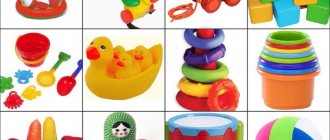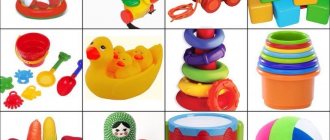What is the volume of a newborn's stomach?
It’s incredible, but the volume of a newly born baby’s stomach is less than 7 ml. That is, the size of the organ can be compared to a thimble, which can hold no more than a teaspoon of milk. On the first day of a child’s life, the mucous walls of the stomach are dense and inelastic; they are simply not able to accept large amounts of food.
If a newborn eats too much, then he still has to regurgitate the excess milk. But there is no need to worry that the child’s body receives few useful substances: the mother’s mammary glands during the first few days produce colostrum, a highly nutritious and easily digestible substance. The child grows at a rapid pace: after three days the volume of the stomach is 30 ml, after a week - 80 ml, and by the end of the month - almost 150 ml.
First feeding
Almost always, milk is noticeably produced in young mothers on the fourth day after birth. But the baby asks to eat already on the second day. Most parents who have not previously fed their children begin to worry whether the milk that appears will be enough.
In this case, there is no need to worry because:
- In newborn babies, the sucking reflex has not yet developed, so they do not drink a lot of milk; at birth, the first feeding usually takes a few minutes; when the baby learns to properly suckle from his mother’s breast, he will already have enough milk;
- In the first days, the mother produces not milk, but colostrum, which has a high fat content and nutrients. A small portion is enough to make the newborn feel good;
- colostrum is formed quickly, but in small quantities - in ten feedings within twenty-four hours, the baby can receive a daily volume of milk of 100 milliliters;
- newly born babies will not need much food;
- lactation begins to appear already on the first day, even if there was no hint of it after the birth of the baby.
Important! anxiety can lead to stress, which, on the contrary, will negatively affect its appearance.
A woman should not worry that colostrum will negatively affect the baby. Scientists have proven that the substance is essential for a newborn. It strengthens the baby's immunity and also allows him to grow healthy and strong.
How much should a newborn baby eat in the first three days of life?
The feeding procedure in women who have given birth for the first time causes panic. This is not surprising, because advice from medical manuals often turns out to be inapplicable in practice. Young mothers should not worry: calculating the amount of milk for newborn babies is not as difficult as it seems.
Babies who cannot yet make active sucking movements with their mouths absorb a small amount of food from the breast, but a few drops of nourishing and nutritious colostrum are enough for them.
Since the stomach of a newborn on the first day of life is not able to accept no more than 8 ml of milk per feeding, and the daily portion of food is 100 ml, mothers need to breastfeed at least 12 times. On the second day, the amount of colostrum consumed increases to 250 ml, and on the third – to 350 ml.
Feeding rates in the first ten days
The first ten days are the most important for the formation of the baby’s body. Proper nutrition allows you to avoid many diseases and problems in the future. To calculate how much formula a newborn should eat, special formulas have been created. They are calculated based on the fact that the baby grows and develops quickly, and the volume of the newborn’s stomach increases.
Every day the dose should be increased:
- on the day of his birth, the baby needs at least 100 milliliters of milk;
- on the second day - no less than 200 and no more than 240 milliliters;
- on the third day - no less than 300 and no more than 340 milliliters.
For the next forty-eight hours, the dose per feeding is 20 milliliters. Every day it needs to be increased by 10 milliliters.
The exact volume can be calculated using 2 formulas:
- multiply the number of days the baby is old by 10;
- subtract a certain number from his body weight depending on age.
How much formula should a newborn eat?
Just as with natural feeding, the baby needs to eat at least ten times a day, and the volume of artificial formula consumed should be the same as breast milk. If the baby does not want to eat often, then the portion of the mixture can be slightly increased. You should not overfeed your baby, even if he has a good appetite. The table shows the recommended daily servings of artificial formula:
How can you tell if your baby is full?
Undernutrition or overnutrition for a newborn baby is fraught with negative consequences in the form of health problems. Therefore, the question of how to determine that a child is full is one of the most important for young parents.
This can be understood by the following signs:
- the baby is happy and smiling;
- he has healthy long sleep;
- urinating more than ten times in 24 hours;
- the baby almost always empties his bowels after he has been given something to eat;
- stool is dark yellow and mushy in shape;
- the baby's skin is pinkish and elastic;
- his body grows proportionally and his weight increases;
- When the baby is not sleeping, he is active.
Note! Overeating also has negative consequences. As with malnutrition, it impairs sleep. The baby may quickly gain weight and refuse to eat. If the child does not want to eat, although the portions are small, you should consult a doctor. If the baby has eaten the rationed portion, but asks for more, there is no need to overfeed him.
How to calculate the daily amount of breast milk according to Maslov
Soviet pediatrician Maslov developed a caloric method for determining the amount of milk needed by a newborn baby. To make the correct calculation, you need to know the exact weight of the baby. A liter of breast milk contains about 700 kilocalories. One kilogram of a child’s body weight per day needs the following amount of energy:
- up to three months of life – 125 kcal;
- from three to six months – 120 kcal;
- from six to nine months – 110 kcal;
- from nine months to one year – 100 kcal.
To calculate the daily portion of milk, you need to multiply the number of kilocalories by the baby's weight. For example, a two-month-old baby weighs 6 kg. It turns out: 125 kcal × 6 kg = 750 kcal. In this case, the child needs to consume a little more than half a liter of breast milk per day.
How to tell if your newborn baby is getting enough food
The most reliable indicator of a child’s adequate nutrition is a steadily increasing body weight and length. Every month the baby must be weighed at the clinic. Upon examination, the pediatrician determines whether the baby is malnourished or, conversely, eats too much in a day. The table below gives the normal weight gain for a child from birth to one year.
The table shows the average data; if the baby’s weight deviates slightly from the norm, then there is nothing to worry about. But if body weight differs too much from the table values, then most likely the child is starving or, conversely, overeating. In this case, you should definitely consult a pediatrician.
Video:
How to determine if your baby has enough milk:
Should you breastfeed by the hour or on demand?
How does a baby eat in the first 24 hours of life:
While in the maternity hospital, the young mother's constant assistants are nurses and doctors who give advice on proper feeding and care for the newborn baby. When leaving the maternity hospital, most, even experienced women, are faced with problems of proper distribution of breast milk during breastfeeding, so that the baby does not suffer from a lack or excess of food.
Medical specialists made calculations and determined the optimal amount of food a child should eat by month, as well as the required frequency of breastfeeding. One of the main indicators of proper feeding is weight gain. These indicators are informed during routine medical examinations or patronage.
Feeding volume up to 1 month
After the baby is born, the nurse or midwife must bring it to the mother's breast for the first attachment. There is no breast milk during this period, but the produced colostrum provides the newborn’s body with essential nutrients.
On the 2nd day after birth, the baby begins to show signs of hunger every 3 hours. Each application to the breast, according to the amount of food eaten, ranges from 10 to 20 ml. A baby can eat up to 100 ml per day.
On the 3rd day after childbirth, breast milk production increases significantly in a nursing woman. By this time, the child has fully mastered the technique of sucking the breast, and the amount of food eaten increases. On average, a baby can eat from 120 to 180 ml per day, or about 30 ml at a time.
By the end of the first week after birth, the baby can eat from 50 to 70 ml per breastfeeding. The daily volume in this case is up to 400 ml. For 2 weeks, the baby consumes up to 500 ml of milk per day.
When the baby is one month old, the normal indicators are the frequency of attachments from 6 to 8 per day, and the amount of breast milk consumed is 90-100 per attachment to the breast.
Of course, this statistics is generalized, and the indicators can be individual for each newborn.
Infant nutrition: types and features
The nutrition of children under one year old largely depends on whether the mother has the opportunity to practice breastfeeding . In the first year of a baby’s life, three main types of feeding are used: natural, artificial, and mixed.
- Natural - in the first 4-6 months, the baby’s diet consists of mother’s milk completely or 80%.
- Artificial - an artificial child receives exclusively formula milk, or the share of mother's milk per day is up to 20%.
- Mixed - the baby’s “menu” consists of breast milk less than 80% and more than 20%, and at the same time he is supplemented with adapted formulas.
Nutrition of a child at 6 months involves the introduction of complementary foods, for which it is necessary to use the correct baby food recipes.
Development and nutrition are interconnected, and modern pediatricians from all over the world agree that natural feeding is the most preferable in this case. In this case, the baby receives the optimal set of substances his body needs, normal intestinal microflora allergies .
Complementary foods are gradually introduced into the menu of a six-month-old baby, since for the health of the baby at 6 months. a wider range of useful and nutritious substances is required.
So, summing up the above, we can highlight the following features of the baby’s nutrition menu in the first year of life:
- The child's nutrition at 4 months and until this time involves 100% feeding with mother's milk. If this is not possible, adapted mixtures . At the same time, the mother should eat a varied diet in order to accustom the baby to different tastes through milk.
- In the period from four and a half to 6 months, the diet should still include breast milk or formula, but at the same time, complementary feeding can be gradually introduced into the menu of an infant or artificial baby. Products are administered one at a time and given for up to 5 days in a row. This regimen is important to determine how the child reacts to a new product. At this time, it is worth giving children pureed vegetables or fruits with one component, cereals, and juices. But a baby's diet at 6 months should still include breast milk as a main component.
- In the period from 6 to 8 months, complementary foods continue to be added to the diet - meat puree, as well as pureed vegetables and fruits with several components. It is very important that the diet of an 8-month-old baby includes vegetables. If they are included in his menu at this age and later, then in the future the child will willingly eat vegetables.
- From 8 to 12 months, the baby is already given puree with small pieces, as well as cookies and crackers. A child's diet at 11 months and a year is already quite varied, although in some cases partial breastfeeding continues for up to a year.
Amount of nutrition for 6-12 months
From 6 months to the first year of life, the baby should eat from 170 to 250 ml of milk or formula once a day. During this period, 1 or 2 feedings are replaced with complementary feeding products (porridge, purees, juices).
If the child is on artificial nutrition, then the required amount of the finished formula can be found on the baby food packaging. Manufacturers of formulas indicate in detail the volume of dry formula and liquid required for preparing ready-made food, as well as the rate of its consumption for children of different ages.
The most complete nutrition chart for babies from birth to one year
Up to 4-6 months, the baby's main source of nutrition is breast milk. If for some reason the mother cannot breastfeed, the child switches to infant formula. There is also a mixed nutrition option: 50/50 – breast milk/formula.
Register and receive a detailed program for the course “Allergies in children”
Complementary foods begin to be introduced at approximately 6 months. Useful information about what and in what volume should be included in a child’s diet is contained in this table.
| Type of food | Introduction period | Where to start | Portion volume |
| Vegetable puree | From 6 months. If the baby is overweight, then this type of complementary feeding will be preferable. | One-component purees from zucchini, pumpkin and cauliflower. | Start with half a teaspoon, gradually increase the volume to 100-150-200 g. |
| Dairy-free porridge | In the absence of contraindications, complementary feeding should begin at 6 months. If the baby is underweight, then complementary feeding can be introduced earlier - from 4-5 months. | Gluten-free cereals: corn, rice, buckwheat. If such porridges are well digested, you can try oatmeal, then multi-ingredient cereal porridges. | Start with half a teaspoon, gradually increase the volume to 100-150-200 g. |
| Milk porridge | From about 8 months. | Gluten-free cereals: corn, rice, buckwheat. If such porridges are well digested, you can try oatmeal. Then introduce multi-component cereal porridges. | Start with half a teaspoon, gradually increase the volume to 100-150-200 g. |
| Semolina, pearl barley, millet, barley porridge | From 1 year in the absence of negative reactions from the baby’s body. | First, you need to give heavily boiled one-ingredient porridges. | Start with 2-3 teaspoons, gradually increase the volume to 200-250 g. |
| Meat puree | From 8 months | Puree from turkey, chicken or rabbit meat. You can give soups made with meat broth. | Start with half a teaspoon, gradually increase the volume to 50-70-100 g. |
| Fruit puree | From 7-8 months | You should start with soft fruits, then move on to multi-component purees. | Start with half a teaspoon, gradually increase the volume to 100-150-200 g. |
| Berry puree | From 12 months | It is necessary to monitor the reaction. If this complementary food causes an allergy, then its introduction should be postponed. | Start with half a teaspoon, gradually increase the volume to 100-150 g. |
| Dairy products | From 9 months | Kefir or yogurt for children without additives. | Start with half a teaspoon, gradually increase the volume to 150-200 g. |
| Read in our blog: “12 foods that should not be given to your baby” | |||
| Cottage cheese | From 8 months | Cottage cheese without additives. | Start with half a teaspoon, gradually increase the volume to 50 g, and from one year to 100 g. |
| From 10 months | Cottage cheese with various additives | You need to start with 1/8 teaspoon, gradually increase the volume to ½. | |
| Children's cookies | From 9-10 months | You need to start with 1/8, gradually increase the portion to 1 piece, and by the year - to 5 pieces. | |
| Fish | From 10 months, if there are no allergies. Otherwise, not earlier than 12 months. | It is recommended to start with fillets of sea, ocean or river fish. Fish should be lean. Be sure to ensure that all the seeds are removed. Feed your baby a fish dish 1-2 times a week. | Start with half a teaspoon, gradually increase the volume to 150-200 g. |
| Juices | From 10-12 months | You need to start with clarified juices from white and green fruits: apple, plum, apricot. Citrus fruits can be used no earlier than 11-12 months. It is important to ensure that the baby does not have allergies. | Start with a few drops, gradually increase the volume, but not more than 100 ml. |
| Vegetable oil | From 6 months | Sunflower, olive or corn. | Start with 3-5 drops, gradually increase to 1 teaspoon. Add to meat or vegetable puree. |
| Butter | From 7 months | Start with 1/8 teaspoon, gradually increase the volume to 10-20 grams. Add to porridge or vegetable puree. | |
| Yolk | From 8-9 months | Yolk of a chicken or quail egg. You can give half an yolk every day until the end of the year before feeding, after grinding it with milk or a complementary food dish. | Start with ¼ yolk, gradually increase the volume to 1 piece. |
| |||
How to Determine Nutritional Adequacy
Knowing the required amount of food consumed according to age, each woman can use techniques to determine nutritional adequacy. To determine, it is recommended to use the following tips:
- Pumping before feeding. The accuracy of this method remains in doubt, but it can be used to determine the approximate volume of breast milk consumed. It is recommended to express carefully and thoroughly, immediately before feeding. Even the right approach cannot ensure complete emptying of the mammary glands. During normal breastfeeding, the baby eats 15-20 ml more than the expressed volume. This is important to take into account when making calculations.
- Using household scales. To determine the amount of food eaten, it is necessary to weigh the baby before feeding and immediately after feeding. The difference in weight will be equal to the amount of food eaten. Before weighing, the child must be completely undressed and freed from diapers and nappies, which may cause excess weight.
- The behavior of a baby can tell a lot. If the newborn is calm, cries occasionally, is not capricious, is friendly, and gains weight according to age and normal, then we can say with confidence that he is receiving enough food.
How to solve the problem of malnutrition
If for some reason the newborn does not receive the proper amount of food, then his behavior speaks for itself. When malnourished, children become capricious, whiny and irritable. In addition, poor weight gain is a reliable indicator of malnutrition.
You can solve the problem of malnutrition with the following tips:
- Increasing the frequency of breastfeeding. This method is very effective and allows you to solve the problem of malnutrition in a matter of days. Increasing the frequency of feedings stimulates milk production, thereby providing the baby with the necessary volume.
- The minimum duration of feeding should be at least 20-25 minutes. Artificially shortening the duration often leads to malnutrition.
- Increasing the volume of fluid you drink. We are talking about a nursing woman who must consume at least 2 liters of fluid daily to ensure normal lactation.
- A nursing woman is not recommended to artificially increase the fat content of breast milk by consuming fatty foods. These actions will not contribute to the speedy saturation of the baby during feeding.
- Only a pediatrician can determine the required amount of food, taking into account the individual characteristics of the child.











